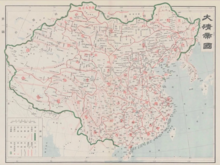The Qing dynasty was a Manchu-led imperial Chinese dynasty and last imperial dynasty in Chinese history. The administrative system of the Qing dynasty was based on the idea of "adapting to the times and the place, and making adjustments according to circumstances".[1]



The Interior Provinces
editInitially
editInitially, the Qing dynasty expanded the Ming province system from 15 to 18 provinces, with the interior of the Qing dynasty comprising Beijing (the capital city) and these eighteen provinces (also known as China proper).
During the Late Qing
editDuring the late Qing dynasty, there were efforts to extend the province system of China proper to the rest of the empire. Xinjiang was reorganized into a province in 1884 and later Manchuria was split into the three provinces of Fengtian, Jilin and Heilongjiang in 1907. Taiwan was converted into a separate province in 1885, but was then ceded to Japan in 1895 following the First Sino-Japanese War.
There was discussion to do the same in Inner and Outer Mongolia and Tibet-Qinghai, but these proposals were not put to practice, and these areas remained outside the provincial system of China proper when the Qing dynasty fell.
Governance over the Provinces
editUnlike the Ming provincial administration which consisted of three governors the Qing provinces were governed by a single Governor or "Xunfu (巡抚)" who held substantial power. Although all provincial agencies communicated with the central government through him, he himself was subordinate to a Governors-general "Zongdu (总督)". While nominally superior to a Governor, usually the Governors-general cooperated closely with the Governor and acted jointly in reporting to the central government.[2]
Under the authority of the Governors were two types of agencies: the Provincial Administration Commissions and the Provincial Surveillance Commissions. The Provincial Administration Commissioner, acting as a lieutenant-general, handled financial duties. The Provincial Surveillance Commissioner managed judicial and oversight functions. Additionally, each province had an unofficial Provincial Education Commissioner who oversaw educational institutions and certified candidates for the civil service exams. Circuit Intendants, known as "Daotai (道臺)" operated within the provincial administration as liaisons between the prefectures and the provincial authorities.[3]
Regions
editChina in the Qing dynasty was divided into five major regions: The Interior (Beijing and eighteen provinces), Guandong (Three Eastern Provinces), Xinjiang (Chinese Turkestan), the Mongolian steppe (Inner and Outer Mongolia), Qinghai and Tibet.[4] The Qing government agency known as Lifan Yuan oversaw the administrations of the empire's Inner Asian territories, which were also collectively known as Chinese Tartary by contemporary Europeans.
Tributary States and Vassals
editThe Qing dynasty had a total of approximately 19 tributary states and a few vassals (not all at the same time) under the traditional tributary system of China.[5]
| State | Start of Tribute/Vassalage | End of Tribute/Vassalage | Notes |
|---|---|---|---|
| Joseon | since the Ming | 1895 | The Qing had a laissez-faire policy towards them.[6]
Japanese occupied by 1894, later annexed by Japan. |
| Ryukyu | 1646 | 1875 | Incorporated into Okinawa Prefecture in 1879, thus
all relations to China ended. Last tribute sent in 1875. |
| Sulu | 1726 | 1733 | Was a Tributary state of the Ming around 300 years
before restarting Tributary relations with China.[7] |
| Vietnam | between the Tang & Song | 1885 | |
| Luang Prabang | 1730 | 1893 | |
| Thailand | since the Sui | 1852 | |
| Konbaung | 1770 | 1885 | Konbaung fought four wars successfully against the Qing,
despite victory they sued for peace with China in 1770. |
| Sikkim | 1720 | 1890 | Sikkim became a protectorate of Tibet in 1670, which itself
became a part of Qing China (and with it Sikkim) in 1720. |
| Nepal | 1791 | 1908 | |
| Hunza | 1761 | 1892 | |
| Kokand | 1774 | 1798 | Forced into being a protectorate of, and pay tribute to,
the Qing dynasty.[8] |
| Kazakhstan | Unknown | 1847 |
See also
edit- Administrative divisions of the Tang dynasty
- Administrative divisions of the Liao dynasty
- Administrative divisions of the Yuan dynasty
- Administration of territory in dynastic China
- Administrative divisions of China
- History of the administrative divisions of China
- Government of the Qing dynasty
- Tributary system of China
References
edit- ^ "大清一統志 - 中國哲學書電子化計劃". ctext.org (in Chinese (Taiwan)). Retrieved 2024-06-27.
- ^ Charles Hucker (1987), A Dictionary of Official Titles in Imperial China. Page 88
- ^ Charles Hucker (1987), A Dictionary of Official Titles in Imperial China. Page 89
- ^ "读者云门户". read.nlc.cn. Retrieved 2024-06-27.
- ^ "清朝20个藩属国结局:10个消亡,1个坚持朝贡到1935年_王国". Sohu. 2021-02-14. Archived from the original on 2021-02-14. Retrieved 2024-06-27.
- ^ Lin, Ming-te (1991). "Li Hung-chang's Suzerain Policy toward Korea, 1882-1894". Chinese Studies in History. 24 (4): 69–96. doi:10.2753/CSH0009-4633240469. ISSN 0009-4633.
- ^ Vienne, Marie-Sybille de (2015-03-09). Brunei: From the Age of Commerce to the 21st Century. NUS Press. p. 73. ISBN 978-9971-69-818-8.
- ^ S. Frederick Starr, Ferghana Valley: The Heart of Central Asia